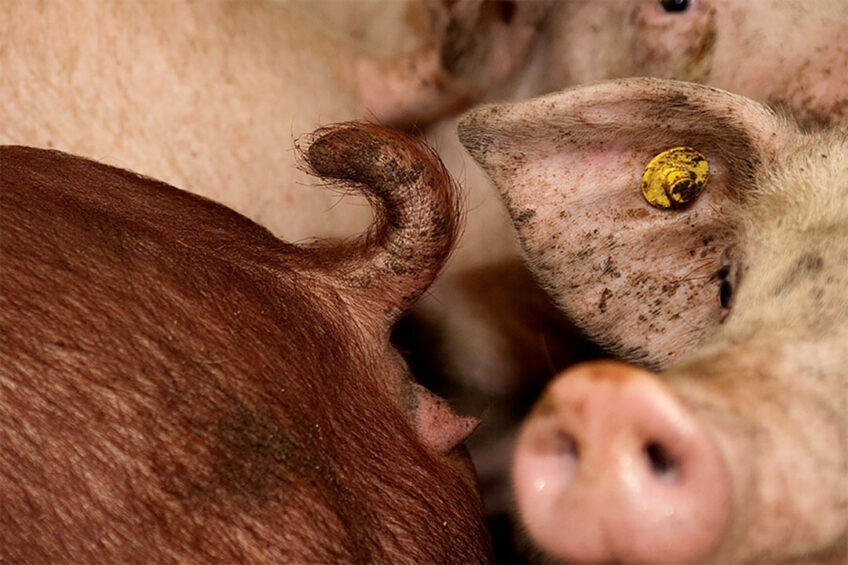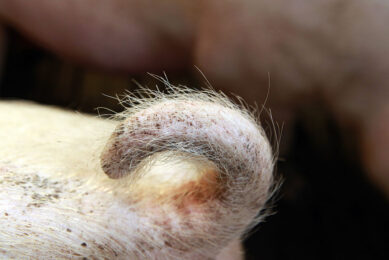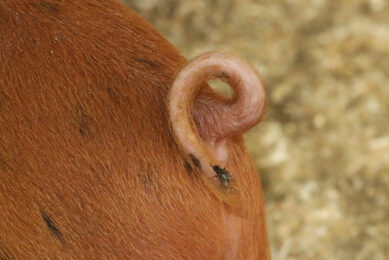Does diet affect tail biting in pigs?

The dietary composition selected for optimum performance for the average pig may be involved in disrupting gut health and the predisposition to tail biting. How does this work?
Tail biting is an abnormal, pathological behaviour and a major health and welfare issue in commercial pig production systems. It is a multi-factorial challenge associated with various risk factors.
Key risk factors for tail biting
The key risk factors for tail biting include enrichment, climate, health and fitness, competition over resources, diet, pen structure and cleanliness. Diet-related risk factors that enhance the chances of tail biting include feed composition, feed quality, the feed amount consumed, protein and amino acid imbalances, feed form, phase-feeding strategy, and poor accessibility to feed. Research studies on the direct involvement of diet on tail biting behaviour are limited. The mechanisms through which the risk factors influence tail biting remain unknown.
Impact of gut microbiota on tail biting
Gut microbiota is an important link between health and behaviour via the microbiota-gut-brain axis. Tail biters and tail biting victims are more stress sensitive and more fearful than neutral pigs. Pigs with tail lesions are shy, show higher activity, and more pig- and pen-directed manipulative behaviours. Tail biters are bold and spend more time exploring.
There are differences in the gut microbiota composition and diversity of tail biters and tail biting victims, as well. In addition, studies found an increased level of Lactobacillus, which is important for an adequate immune function. It decreases when neutral pigs experience stress. In addition, pro-inflammatory cytokines produced by the immune system induce sickness behaviour. They also lower the stress resilience of individual pigs, and increase the incidence of tail biting.
Impact of dietary composition
The dietary composition selected for optimum performance for the average pig may be involved in disrupting gut health and the predisposition to tail biting. Dietary fiber impacts gut health and tail biting predisposition by providing physical structure to the digesta, increasing the feelings of satiety, controlling feed intake, and reducing the risk of gastric ulcers. In addition, dietary fiber regulates digestive processes, controls transit time, and contributes to the control of circulating glucose and lipid levels.
Finally, dietary fiber acts as an energy substrate for microbial fermentation and decreases the formation of toxic metabolites. Moreover, feed form affects the tail biting risk by causing gastric ulcer development via a more fluid digesta. It does so by activating immune response, and by causing gastro-intestinal discomfort which motivates chewing behaviour and tail biting. More coarsely ground feed affects the consistency of the stomach content. It also slows down gastric emptying rates, increases microbial diversity, and mitigates gastric ulcer development.
Impact of protein and amino acid imbalances
Diets with low dietary protein levels, imbalance in essential amino acids, and mineral deficiency enhance the occurrence of tail biting. Protein deficiency increases the foraging motivation and tail-mouth behaviour; thus, increasing the risk of tail biting. Mineral deficiency enhances attraction to blood and accelerates tail biting behaviour.
Protein and amino acids at the recommended levels for growth are insufficient to prevent tail biting in pigs that are reared under poor sanitary conditions due to a higher demand of specific amino acids such as tryptophan and threonine when the immune system is stimulated. A high availability of dietary protein leads to pathogenic bacteria colonization, gut leakage, and gut inflammation which in turn stimulate tail biting behaviour.
Tryptophan is a precursor of serotonin which is an important neurotransmitter. it is involved in processes including mood, stress sensitivity, regulation of gut motility, appetite, immune function, sleep, and memory. Therefore, an insufficient supply of tryptophan or an imbalance between tryptophan and tyrosine, isoleucine, leucine, valine, and phenylalanine is associated with the development of tail biting in pigs.
Concluding remarks
Tail biting is one of the main health and welfare concerns in commercial pig production systems. It is suggested that diet can be a risk factor for tail biting through immune system activation, psychological stress, dysbiosis of the gut microbiota, and disruption of the intestinal epithelium. Diet-related risk factors for tail biting include under- and oversupplied protein and a lack of satiation. They also include small feed particle size, and low dietary fiber content. Further research is required to investigate diet-related pathways for the development of tail biting.
 Beheer
Beheer








 WP Admin
WP Admin  Bewerk bericht
Bewerk bericht